
| Abercynon | |
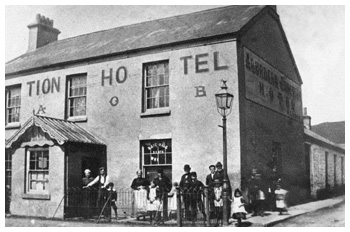 |
The origins of the village of Abercynon lay in its importance as a centre for traffic with the Glamorgan Canal, the Aberdare Canal and the Taff Vale Railway all passing through the district. The presence of these important communication networks having led to its development on a small scale. Public houses and hotels such as the Junction Hotel, The Swan, The Boatman, New Inn, Navigation Hotel and the Traveller's Rest were established to cater for the passing trade and the employees of the canals and railways. Left: Junction Hotel Abercynon c 1900 |
| A combined post office and general store was opened and houses built alongside the canal to house the workmen. Some of the names by which the village was formally known reflect the importance of these networks to the village. These include Navigation, Y Basin and Aberdare Junction. The name Abercynon was only introduced in 1893 when a public meeting was held to find a permanent name for the village.The sinking of the collieries in 1889 brought a great influx of people into the village leading to the development of the modern town of Abercynon. Streets beginning to appear along the sides of the valley in order to accommodate the ever-growing population. Some of the earliest being Martin's Terrace, Station Terrace (now Ynysmeurig Road), Catherine Street (now Herbert Street). With commercial centres being established and other buildings of significance opened including the new Navigation School (1896) and the Workmen's Hall (1905). | |
The increase in population brought the followers of many religious denominations into the village and chapels and churches were established to cater for their religious needs. These include Calfaria chapel opened by the baptists in 1894, Bethania Chapel opened by the Welsh Independents in 1896 and St Donat's Church by the Church of England in 1908. Right: Glancynon Terrace and Calfaria Baptist Church |
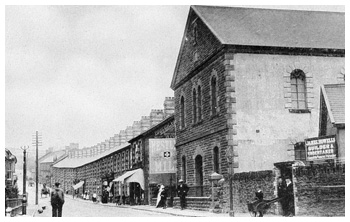 |
Abercynon Coal Industry |
|
| The production of coal in Abercynon did not begin in any significant levels until the latter part of the 19th century, with the sinking of collieries taking place at a later date than further up the Cynon Valley. A contributing factor to this being the depth at which the coal seams lay from the surface. For example the Gellideg seam was 146 yards below the surface at Aberdare and 170 yards below the surface at Abercynon. This greater depth meant any collieries sunk in Abercynon would have to be deeper and larger adding to the cost of the already expensive process of mining coal. However these problems were overcome and the following successful enterprises were established in Abercynon | |
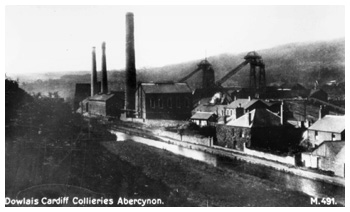 |
Abercynon Colliery Originally called Dowlais Cardiff Colliery, this colliery was sunk by the Dowlais Iron Company. Sinking operations commenced in 1889 but soon encountered difficulties with excessive water in the pits. Pumps were installed to counter this problem and the sinking was completed by 1906. At the time of their completion these pits were the deepest in the South Wales Coalfield. The Dowlais Iron Company was changed to Guest Keen and Company in 1901, and in 1903, Guest Keen and Nettlefolds Limited was formed. They later pulled out of mining operations in South Wales and by 1931 the colliery was in the hands of Welsh Associated Collieries Limited who merged with Powell Duffryn in 1935 to form Powell Duffryn Associated Collieries Limited. |
| Above: Abercynon or Dowlais Colliery was one of the deepest in South Wales at the time it was sunk | On nationalisation of the coal industry in 1947 the colliery came under the control of the National Coal Board who linked the colliery below ground to Lady Windsor Colliery, Ynysybwl, in 1971. The National Coal Board closed the colliery in 1988. |
Carne Park Colliery A relatively small enterprise consisting of a number of levels situated to the south west of St Donat's Church. The exact date of its opening is not known, but it was working by 1864, although its owner at that time is unknown. By 1910 it was in the hands of the Carne Park Colliery Co. Ltd. and although it went bankrupt in 1911, it was operating again by 1916 under the control of the Richardson Brothers. The colliery was not nationalised in 1947 and in 1957 D. Leonard and Partners owned it. The actual date of closure is unknown. Right: Abercynon junction c 1905 |
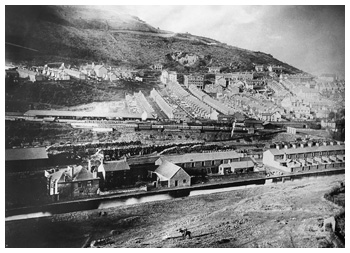 |
Richard Trevithick |
|
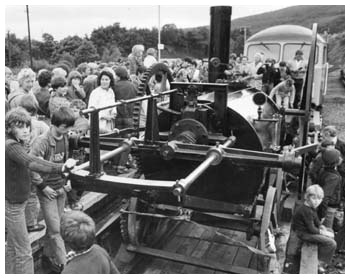 |
Richard Trevithick was an engineer from Cornwall who while employed at Pen-y-Darran ironworks near Merthyr Tydfil pioneered the first steam locomotive ever tried upon a railway. It was his employer the ironmaster Samuel Homfray who laid a wager of 500 guineas that he could haul a load of ten tons of iron from Merthyr Tydfil to the Basin (Abercynon) on a train drawn by a steam locomotive. It was on the 22nd. February 1804, that Trevithick's High Pressure Steam Engine began its journey carrying ten tons of iron, seventy men and five wagons. Unfortunately the chimney of the engine struck a low bridge shortly after the start, and the bridge and chimney were both damaged. Trevithick having rebuilt the chimney carried on his way, finally arriving at the basin having travelled nine and half miles at a rate of nearly five miles an hour, thereby winning his employer the wager. Left: A replica of Trevithick's original loco |